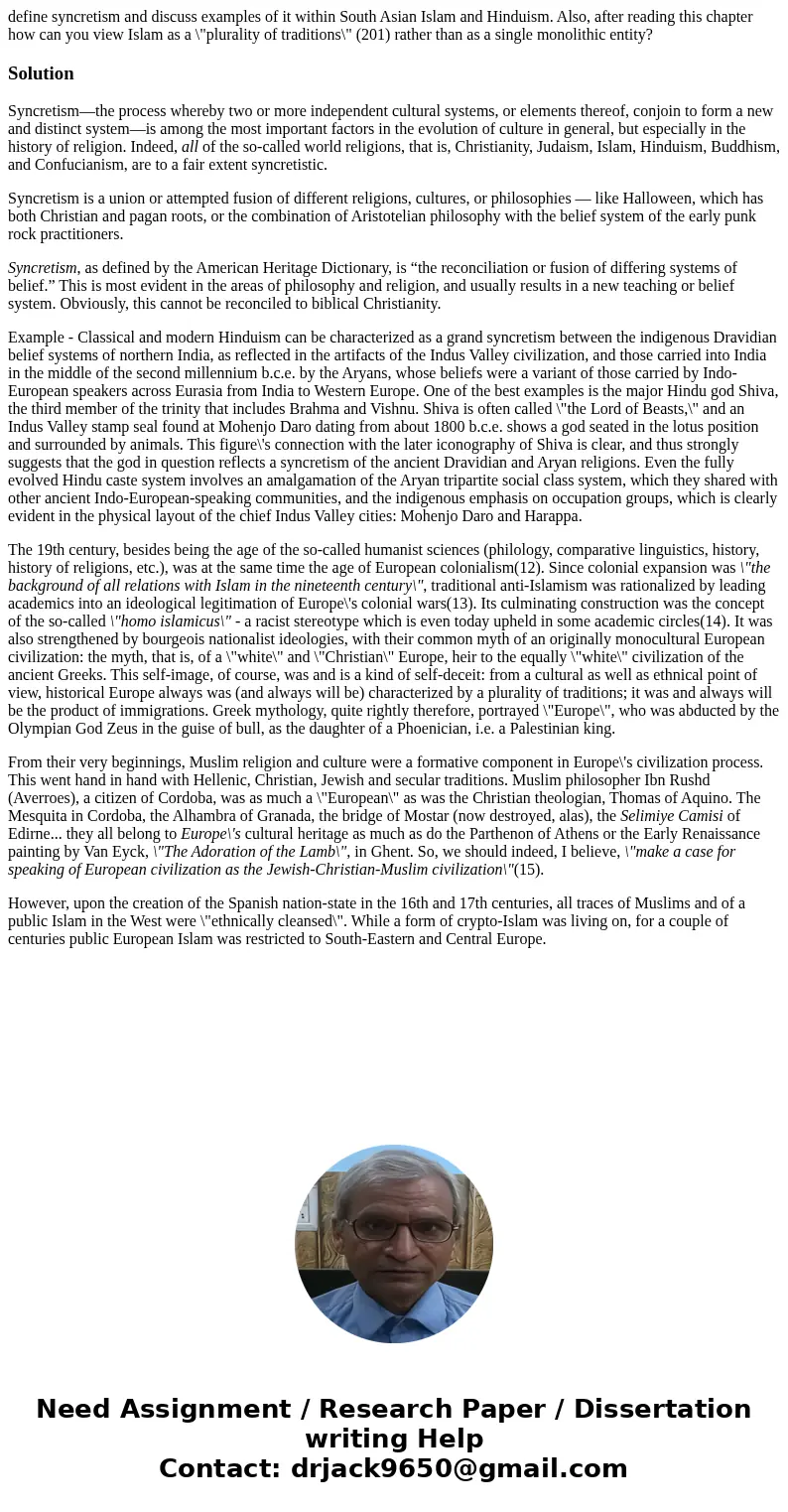define syncretism and discuss examples of it within South As
define syncretism and discuss examples of it within South Asian Islam and Hinduism. Also, after reading this chapter how can you view Islam as a \"plurality of traditions\" (201) rather than as a single monolithic entity?
Solution
Syncretism—the process whereby two or more independent cultural systems, or elements thereof, conjoin to form a new and distinct system—is among the most important factors in the evolution of culture in general, but especially in the history of religion. Indeed, all of the so-called world religions, that is, Christianity, Judaism, Islam, Hinduism, Buddhism, and Confucianism, are to a fair extent syncretistic.
Syncretism is a union or attempted fusion of different religions, cultures, or philosophies — like Halloween, which has both Christian and pagan roots, or the combination of Aristotelian philosophy with the belief system of the early punk rock practitioners.
Syncretism, as defined by the American Heritage Dictionary, is “the reconciliation or fusion of differing systems of belief.” This is most evident in the areas of philosophy and religion, and usually results in a new teaching or belief system. Obviously, this cannot be reconciled to biblical Christianity.
Example - Classical and modern Hinduism can be characterized as a grand syncretism between the indigenous Dravidian belief systems of northern India, as reflected in the artifacts of the Indus Valley civilization, and those carried into India in the middle of the second millennium b.c.e. by the Aryans, whose beliefs were a variant of those carried by Indo-European speakers across Eurasia from India to Western Europe. One of the best examples is the major Hindu god Shiva, the third member of the trinity that includes Brahma and Vishnu. Shiva is often called \"the Lord of Beasts,\" and an Indus Valley stamp seal found at Mohenjo Daro dating from about 1800 b.c.e. shows a god seated in the lotus position and surrounded by animals. This figure\'s connection with the later iconography of Shiva is clear, and thus strongly suggests that the god in question reflects a syncretism of the ancient Dravidian and Aryan religions. Even the fully evolved Hindu caste system involves an amalgamation of the Aryan tripartite social class system, which they shared with other ancient Indo-European-speaking communities, and the indigenous emphasis on occupation groups, which is clearly evident in the physical layout of the chief Indus Valley cities: Mohenjo Daro and Harappa.
The 19th century, besides being the age of the so-called humanist sciences (philology, comparative linguistics, history, history of religions, etc.), was at the same time the age of European colonialism(12). Since colonial expansion was \"the background of all relations with Islam in the nineteenth century\", traditional anti-Islamism was rationalized by leading academics into an ideological legitimation of Europe\'s colonial wars(13). Its culminating construction was the concept of the so-called \"homo islamicus\" - a racist stereotype which is even today upheld in some academic circles(14). It was also strengthened by bourgeois nationalist ideologies, with their common myth of an originally monocultural European civilization: the myth, that is, of a \"white\" and \"Christian\" Europe, heir to the equally \"white\" civilization of the ancient Greeks. This self-image, of course, was and is a kind of self-deceit: from a cultural as well as ethnical point of view, historical Europe always was (and always will be) characterized by a plurality of traditions; it was and always will be the product of immigrations. Greek mythology, quite rightly therefore, portrayed \"Europe\", who was abducted by the Olympian God Zeus in the guise of bull, as the daughter of a Phoenician, i.e. a Palestinian king.
From their very beginnings, Muslim religion and culture were a formative component in Europe\'s civilization process. This went hand in hand with Hellenic, Christian, Jewish and secular traditions. Muslim philosopher Ibn Rushd (Averroes), a citizen of Cordoba, was as much a \"European\" as was the Christian theologian, Thomas of Aquino. The Mesquita in Cordoba, the Alhambra of Granada, the bridge of Mostar (now destroyed, alas), the Selimiye Camisi of Edirne... they all belong to Europe\'s cultural heritage as much as do the Parthenon of Athens or the Early Renaissance painting by Van Eyck, \"The Adoration of the Lamb\", in Ghent. So, we should indeed, I believe, \"make a case for speaking of European civilization as the Jewish-Christian-Muslim civilization\"(15).
However, upon the creation of the Spanish nation-state in the 16th and 17th centuries, all traces of Muslims and of a public Islam in the West were \"ethnically cleansed\". While a form of crypto-Islam was living on, for a couple of centuries public European Islam was restricted to South-Eastern and Central Europe.

 Homework Sourse
Homework Sourse